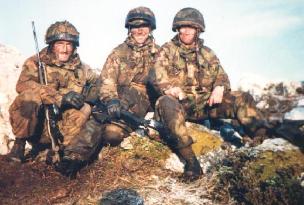Weathering a combat solider effectively comes down to analysing which parts of the soldier's body are likely to come into direct contact with the ground, which parts of the body are likely to remain cleaner than others and what type of terrain the solider is fighting in, and for how long.
It's fair to say that the areas most people concentrate on are the boots and the lower legs. This is clearly a good place to start, as the feet more than any other part of the body are in more or less contastant contact with the ground. The boots themselves can be caked in mud, or lightly dusted. The extent of weathering depends almost entirely on context and the groundwork choices you make. Equally the lower legs, both front and back are likely to be effected by splatter from puddles and also from kneeling on the ground.
Next area of the body to concentrate on is the bum. Sitting down on the ground leaves big dark wet patches on the seat of the trousers and down the back of the legs. If the ground is wet and muddy, this means the entire back side of the trousers could be wet and ingrained with dirt.
Another area, often neglected are the elbows and forearms. Anyone who has had to "hit the deck", leopard crawl or lift themselves off the ground with a full pack will have used their forearms and elbows on the ground, and got dirty doing so. In extreme cases, the entire front of the chest and trousers can be covered in mud if, as I have had the good fortune to do, you have chosen to go to ground in a muddy bog.
Finally, the hands. Very few modellers bother to apply weathering to the hands, but in most cases these are the dirtiest part of a combat soldier's body (except when gloves are worn). Even in 75mm its possible to paint dirt under a figure's finger nails!!
Finally, the face. A soldier lives on the ground, sleeps on the ground and fights on the ground, so his face gets dirty. He often doesn't get a chance to wash himself, so the dirt builds up in the folds and creases of his skin until he looks like a zombie. The only thing to wash the dirt away is sweat, which can leave streak marks on the skin.
Of course, dirt and mud will dry and fall off a uniform over time, which can form several different layers and colours of mud and dirt on a solider's uniform over an extended period in the field. Remember that were the uniform crinkles and folds at the joints, such as the back of the knees, the elbow and shoulder, the movement of the body will tend to make the dirt become more ingrained into the fabric of the uniform.
The extent to which you weather or don't weather your figures is entirely up to you. There is no right or wrong way to do it. I tend to believe in the "more is more" school of weathering, but a more subtle approach, particularly for Napoleonics, may be more appropriate.


